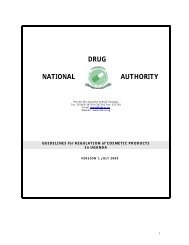guidelines on variations to a registered pharmaceutical product
guidelines on variations to a registered pharmaceutical product
guidelines on variations to a registered pharmaceutical product
- No tags were found...
Create successful ePaper yourself
Turn your PDF publications into a flip-book with our unique Google optimized e-Paper software.
Guidelines <strong>on</strong> Variati<strong>on</strong>s <strong>to</strong> a Registered Pharmaceutical Product3. The manufacturing processes for the currently accepted and proposed <strong>product</strong>s use the sameprinciples (e.g. a change from wet <strong>to</strong> dry granulati<strong>on</strong>, from direct compressi<strong>on</strong> <strong>to</strong> wet/dry granulati<strong>on</strong> orvice versa would be c<strong>on</strong>sidered a change in manufacturing principle), same processing intermediatesand there are no changes <strong>to</strong> any manufacturing solvent used in the process.4. The same classes of equipment, operating procedures, in-process c<strong>on</strong>trols (no widening or deletingof limits) are used for the currently accepted and proposed <strong>product</strong>s; no change in critical processparameters.5. No change in the specificati<strong>on</strong>s of the intermediates or the FPP.6. The change is not necessitated by unexpected events, resulting in failure <strong>to</strong> meet specificati<strong>on</strong>s,arising during manufacture or because of stability c<strong>on</strong>cerns.7. The change does not involve packaging or labeling where the primary packaging provides a meteringand/or delivery functi<strong>on</strong>.8. The change does not c<strong>on</strong>cern a gastro-resistant, modified or prol<strong>on</strong>ged release FPP.9. The change does not affect the sterilizati<strong>on</strong> parameters of a sterile FPP.Documentati<strong>on</strong> required1. Supporting clinical or comparative bioavailability data or justificati<strong>on</strong> for not submitting a newbioequivalence study according <strong>to</strong> the current WHO Guidelines <strong>on</strong> Bioequivalence.2. Discussi<strong>on</strong> <strong>on</strong> the development of the manufacturing process; where applicable:3. comparative in vitro testing, e.g. multipoint dissoluti<strong>on</strong> profiles in the release medium for solid dosageunits (<strong>on</strong>e <strong>product</strong>i<strong>on</strong> batch and comparative data of <strong>on</strong>e batch from the previous process and thebiobatch results, data <strong>on</strong> the next two <strong>product</strong>i<strong>on</strong> batches should be available <strong>on</strong> request or reportedif outside specificati<strong>on</strong>);4. comparative in vitro membrane diffusi<strong>on</strong> (membrane release testing) for n<strong>on</strong>-sterile semisolid dosageforms c<strong>on</strong>taining the API in the dissolved or n<strong>on</strong>-dissolved form (<strong>on</strong>e <strong>product</strong>i<strong>on</strong> batch and comparativedata of <strong>on</strong>e batch from the previous process and the biobatch results, data <strong>on</strong> the next two <strong>product</strong>i<strong>on</strong>batches) should be submitted or be available <strong>on</strong> request;5. microscopic imaging of particles <strong>to</strong> check for visible changes in morphology and comparative sizedistributi<strong>on</strong> data for liquid <strong>product</strong>s in which the API is present in n<strong>on</strong>-dissolved form.6. Batch formula, descripti<strong>on</strong> of manufacturing process and process c<strong>on</strong>trols, c<strong>on</strong>trols of critical stepsand intermediates, process validati<strong>on</strong> pro<strong>to</strong>col and/or evaluati<strong>on</strong>.7. Specificati<strong>on</strong>(s), certificate of analysis for <strong>on</strong>e <strong>product</strong>i<strong>on</strong> scale batch each manufactured according <strong>to</strong>the currently accepted and the proposed processes.8. Results of stability testing generated <strong>on</strong> at least two pilot batches (for uncomplicated <strong>product</strong>s <strong>on</strong>epilot batch, the other <strong>on</strong>e can be smaller) with a minimum of three (3) m<strong>on</strong>ths of accelerated (andintermediate, as appropriate) and three (3) m<strong>on</strong>ths of l<strong>on</strong>g-term testing.9. Updated post-acceptance stability pro<strong>to</strong>col and stability commitment <strong>to</strong> place the first <strong>product</strong>i<strong>on</strong> scalebatch of the proposed <strong>product</strong> in<strong>to</strong> the l<strong>on</strong>g-term stability programme.10. Copies of relevant secti<strong>on</strong>s of blank master <strong>product</strong>i<strong>on</strong> documents with changes highlighted as wellas executed <strong>product</strong>i<strong>on</strong> documentati<strong>on</strong> for <strong>on</strong>e batch and c<strong>on</strong>firmati<strong>on</strong> that there are no changes <strong>to</strong>the currently accepted <strong>product</strong>i<strong>on</strong> documents other than those highlighted.Doc. No.: DAR/GDL/005 Revisi<strong>on</strong> Date: 8 th July 2013 Review Due Date: 16 th July 2016Revisi<strong>on</strong> No.: 1 Effective Date : 16 th July 2013 Page 45 of 70
















